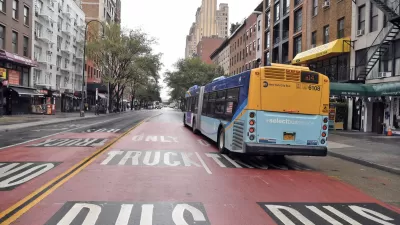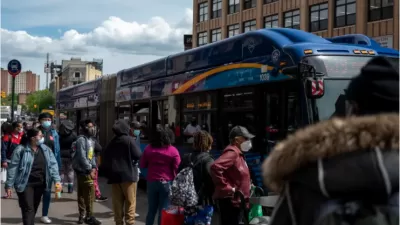Bowing to pressure from business interests, the agency says it won’t build a full busway on Fordham Road.

The New York City Department of Transportation (NYCDOT) is backing out of plans to build a busway on Fordham Road after encountering opposition from local business improvement districts (BIDs) that claim the busway would harm local businesses that “rely on car-dependent customers” and that have won support from local institutions such as the Bronx Zoo and St. Barnabas Hospital. Writing in Streetsblog NYC, Dave Colon points out that “A litany of surveys debunk this claim — including one this past March that found just 6 percent of people who drive to Little Italy on Arthur Avenue oppose a busway.”
According to Colon, the revised plan, which will “shift existing bus lanes away from the curb and extend them by several blocks” instead of a full busway, “will provide the least benefit for long-suffering bus riders.” City Council Member Pierina Sanchez expressed concern that the new plan won’t offer “significant improvements” in travel times. “DOT predicts a 20-percent bus speed improvement from the offset bus lanes versus a 30-percent speed improvement from a busway, according to a DOT spokesperson, who added that every project is unique, and as such cannot be compared to others.”
In a petition, the Riders Alliance calls on the Bronx Zoo and New York Botanical Garden to “stop fighting against better bus service now and use their substantial power to amplify riders’ demand for a busway.”
FULL STORY: DOT Nixes Fordham Road Busway Due To ‘Community Concerns’

Study: Maui’s Plan to Convert Vacation Rentals to Long-Term Housing Could Cause Nearly $1 Billion Economic Loss
The plan would reduce visitor accommodation by 25,% resulting in 1,900 jobs lost.

North Texas Transit Leaders Tout Benefits of TOD for Growing Region
At a summit focused on transit-oriented development, policymakers discussed how North Texas’ expanded light rail system can serve as a tool for economic growth.

Why Should We Subsidize Public Transportation?
Many public transit agencies face financial stress due to rising costs, declining fare revenue, and declining subsidies. Transit advocates must provide a strong business case for increasing public transit funding.

How to Make US Trains Faster
Changes to boarding platforms and a switch to electric trains could improve U.S. passenger rail service without the added cost of high-speed rail.

Columbia’s Revitalized ‘Loop’ Is a Hub for Local Entrepreneurs
A focus on small businesses is helping a commercial corridor in Columbia, Missouri thrive.

Invasive Insect Threatens Minnesota’s Ash Forests
The Emerald Ash Borer is a rapidly spreading invasive pest threatening Minnesota’s ash trees, and homeowners are encouraged to plant diverse replacement species, avoid moving ash firewood, and monitor for signs of infestation.
Urban Design for Planners 1: Software Tools
This six-course series explores essential urban design concepts using open source software and equips planners with the tools they need to participate fully in the urban design process.
Planning for Universal Design
Learn the tools for implementing Universal Design in planning regulations.
Ascent Environmental
Borough of Carlisle
Institute for Housing and Urban Development Studies (IHS)
City of Grandview
Harvard GSD Executive Education
Toledo-Lucas County Plan Commissions
Salt Lake City
NYU Wagner Graduate School of Public Service





























